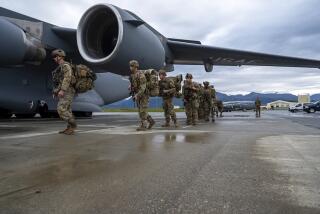Nicaragua Troops Try to Block U.S. Arms
- Share via
WASHINGTON — Nicaraguan counterinsurgency troops have crossed into Honduras and engaged in gun battles in an effort to block the flow of military hardware being sent by the United States to the contras who operate there, a senior Reagan Administration official said Tuesday.
The fighting occurred as Nicaragua, in the last several weeks, began to move units into the region known as the Las Vegas salient--a triangular-shaped area of Honduras on the Nicaraguan border that houses base camps of the U.S.-backed rebels.
Pentagon analysts believe that the deployment of as many as several thousand Sandinista troops represents a concerted effort to block the contras from moving into Nicaragua some of the $100 million in military aid being provided by the United States.
Stemming the Flow of Aid
Sources familiar with the contras’ weaponry said that the rebels have not yet received anti-aircraft missiles that are part of the $100-million package.
Meanwhile, the Associated Press quoted Administration officials as saying the Nicaraguans have received deliveries of SAM-14 missiles from the Soviet Union for the first time. The SAM-14 is a shoulder-fired, anti-aircraft missile that carries a bigger warhead and offers superior range compared to the SAM-7 missiles that the Sandinistas have been using. The officials also said that the SAM-14s would pose a threat to the Honduran air force and “make the resupply of the contras by air a more perilous operation.”
The Nicaraguans, in addition to seeking to stem the flow of the aid to the contras, “seem bent on preempting any major contra offensive,” said a Pentagon official, speaking on condition that he not be identified.
“They’ve brought to bear a fair amount of firepower and helicopters. What they appear to be doing is trying to shortstop a significant move by the contras out of the Las Vegas salient and into Nicaragua during the coming dry season,” he said.
Threat Not Clear
The region is thought to be home to thousands of contras, who use the territory for training and for rest between their forays across the border. However, their presence there is an embarrassment to Honduras, which either ignores them or denies that the guerrillas are using the territory as a base for their efforts to overthrow the Sandinista regime.
But the Pentagon believes that the movement of the Sandinista troops into the territory is not aimed at Honduras, although future actions are uncertain. “Will they go surging over in large numbers? Who is to tell?” the official said.
Thus far, he said, the contras have been unable to dislodge the Sandinistas in the region, but it was unclear whether the development represented a major threat to the anti-Communist forces.
However, Bosco Matamoros, a spokesman for the contras in Washington, said: “It’s a serious situation. We believe the Sandinistas are attempting to encircle our troops, inflict heavy damage, and present a fait accompli before most of the aid arrives.”
Helicopters Pose Problem
The Nicaraguans have employed in the region their Soviet-built MI-8 and MI-25 helicopters, equipped as gunships and as troop carriers, the Pentagon source said.
The use of the helicopters poses a problem for the contras, whose air defenses are made up only of SAM-7 surface-to-air missiles, which are considered unsophisticated weapons.
Nonetheless, a SAM-7 was believed to have been used by the Sandinistas in shooting down a private American cargo plane Oct. 5 that was attempting to drop arms to the contras in southern Nicaragua. Eugene Hasenfus, the only crew member to survive the attack, has been sentenced to 30 years in prison in Nicaragua.
Reports of clashes in the region occur periodically--and are often exaggerated. Independent confirmation of the military activities there is difficult because the area is not open to free movement by reporters.
Times staff writer Doyle McManus contributed to this story.
More to Read
Sign up for Essential California
The most important California stories and recommendations in your inbox every morning.
You may occasionally receive promotional content from the Los Angeles Times.












